★★★★
Turning Red is a welcome departure from the usual Pixar fare, sharing familiar Disney tropes from a fresh perspective.

Disney Pixar’s latest film, Turning Red, is a new look for the studio that revolutionized the animation industry but eventually fell into a rut, retelling familiar stories from a decidedly white male perspective. Turning Red is the studio’s first film solely directed by a woman and features the first Asian lead character since 2009’s Up.
Pixar, in recent years, has branched out from telling white stories. Movies such as Coco and Soul were rooted in Mexican and Black American cultures. But Turning Red takes the coming-of-age genre one step further, telling the story from the perspective of a teenage Chinese Canadian girl. The movie was steeped in early 2000s weird girl call-outs, from Tamagotchis to bland boy bands.
The story explored the perils of rocky parent-child relationships through the lens of an ancient family curse that causes the family’s women to turn into a magical red panda when they experience extreme emotions. The film’s use of the red panda as an allegory for menstruation, the typical time during puberty that signals a body’s transition into adulthood, was clever. But the story was still relatable to those who never experienced that facet of puberty. Mei’s reaction and her family’s response to the changes she experienced were easily transferable to anyone who felt like their body was working against them. Many young people who don’t menstruate still experience a variety of internal monsters at that point in their life, including queer and trans young folk. The sequence where Mei first discovers her red panda, and her visceral reaction to it, immediately reminded me of my teenage struggles with sexuality and gender.

While the premise was relatable, the setting was firmly immigrant Chinese. This gave the movie a fresh feel, despite the familiar family first tropes often seen in Disney films. There are so many cultures to draw from outside of a eurocentric focus. It’s enjoyable to see people with different lived experiences allowed to showcase their stories.
Turning Red still demonstrated Disney Pixar’s usual faults, presenting a world without queerness or transness and a Toronto that was mysteriously devoid of dark-skinned people. But, if you’re able to overlook those faults, Turning Red is an enjoyable, relatable coming-of-age story for people seeking something outside of the white male perspective.

